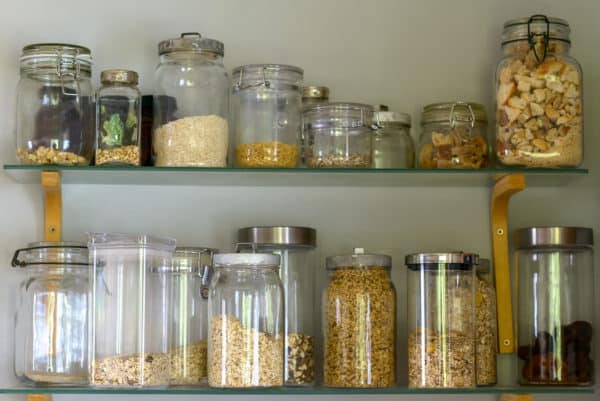READY TO GET STARTED?
REQUEST A FREE ESTIMATE
Fill out the form below or call (888) 466-7849 for a free, no-obligation estimate.

The kitchen is one of the most common rooms in your home to have ants, closely followed by the bathroom. The most common ants found indoors are odorous house ants, also known as nuisance ants. While these ants don’t cause structural damage and aren’t considered dangerous to humans or pets, they can contaminate your food and become quite a nuisance to deal with. Carpenter ants are larger black ants that can also get into your home. These ants do cause structural damage by boring through the wood components of your house.
The ants you find in your home don’t actually live there; they build colonies outdoors and come in looking for food and water to take back. These elements are necessary for the colony to live and grow. Scout ants who find these sources leave a pheromone trail for the rest of the colony to follow which is why you will often see ants traveling in a single line. Because they can scale walls and travel between stories in your home, they can spread quickly and be extremely difficult to get rid of.
Ants are attracted by a number of things found in your home. They use crumbs, spills, loosely sealed food packages, dirty dishes, and even pet food bowls to find food. They use leaky pipes, pet water bowls, and standing water for hydration.
What can you do to keep ants from taking over your kitchen? Prevent ants by:
Killing just the ants you find in your home won’t eliminate the entire infestation. You must eradicate them at the source – at their colonies. These ants can be difficult to eliminate because individual colonies can number in the thousands and they can be spread out all over your property. For assistance in dealing with ants or any other pests you may find in your home, contact your local pest control company for an evaluation.
9 Easy Ways to Keep Birds Away

As we start to gear up for the holidays, many of us begin gathering and storing food supplies for the upcoming months. Unfortunately, these essentials could also be providing stored product pests or “pantry pests” a supply of their own! The most common of these pantry pests, Indianmeal moths and merchant grain beetles, will infest and eat a variety of pantry items such as grains, nuts, chocolates, cake mixes, cookies, and more.
We break down some easy ways to prevent these pests this holiday season so you can get back to what matters most: family time.
Invest in Proper Storage
Utilizing Tupperware-type containers is a great way to keep your pantry organized and keep pantry pests away! Place your grains, uncooked pasta noodles, cookies, or seeds in these containers to protect against pests. Make sure that the containers are made from either glass or plastic, with a tight-fitting lid. Also, consider placing a bay leaf in dry goods such as flour, rice, and other grains – the bay leaf’s smell will help repel many pests.
Inspect Your Groceries
Most of the time, pantry pests are brought into the home from items that have already been infested, such as cardboard, plastic bags, or paper grocery bags. Before purchasing groceries, inspect the food packaging prior to placing them into your cart to buy. If you notice that there is an opening, do not purchase and let an employee know. Before entering your home with groceries, inspect and go through ingredients to make sure there hasn’t already been a pest infestation.
Seal Cracks
Sealing cracks and crevices throughout your home is essential for not letting these pests in. Check around your stovepipes and water pipes for any openings and seal them if needed. Additionally, moisture is a major attraction to any pests. Eliminate any water coming from leaking pipes or clogged drains. Consider investing in a dehumidifier to help with moisture control.
If you suspect pantry pests or have seen them, throw out anything infested and do a thorough cleaning of the entire area. Contact a local pest control company to help identify the pest and provide the best treatment and prevention plan.

It’s finally the holiday season when we can celebrate with our favorite dishes and desserts! While we might find ourselves stocking up on ingredients for our upcoming dinners, you could be providing certain “pantry pests” their holiday meals! Here are two common pantry pests to look out for this holiday season.
Indian Meal Moth
The Indian meal moth is famously known for feeding on pantry items. These pests have a two-toned wing pattern with tan or copper colors throughout their oval-shaped body. They have six legs and a 1/2” to 5/8” wingspan. These insects are highly attracted to light and anywhere they can find food stored. They prefer to feed on dried fruits and vegetables, grains, seeds, nuts, candies, chocolate, pet food, and powdered milk.
Merchant Grain Beetles
The merchant grain beetle has a dark brown body, six legs, and six saw-like teeth on each side of their bodies. Their narrow oval body shape allows them to crawl inside of packaging to eat, live, and reproduce. While their name suggests that they feed on grains, they actually prefer to feed on cereals, cake mixes, macaroni, cookies, and chocolate! Once these insects infest food packages, they immediately contaminate them.
Prevention:

In recent times, we are finding ourselves spending more time at home and stocking up on supplies such as food, toiletries, and more. But as you stock up on these essentials, you could be providing stored product pests or “pantry pests” with a supply of their own. Here are a few tips to keep your kitchen free of these unwelcome guests:
If you take these precautions, you can easily avoid pests from raiding your pantry for all your stored groceries!

As the holidays near, the time you spend in your kitchen increases. However, while you stock up on your holiday baking essentials, you could be providing stored product pests, or “pantry pests”, with their own holiday feast. Here are a few tips to keep your kitchen free of these unwelcome guests:
No one invited these pests to your holiday party in the first place, so taking these precautions can help you enjoy the holiday baking and time with your loved ones. If you think you are having an issue with stored product pests, call your local licensed pest control company to schedule an inspection so you can get back to the sweet smells of the holidays.